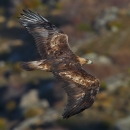The conservation of migratory birds requires identifying how events across their annual cycle (often occurring across vast areas) influence their survival and reproduction. It is thought that most golden eagles in Alaska are migratory and move south during autumn to over-winter in the western contiguous U.S. Thus, factors that may affect the golden eagle population in Alaska (e.g., energy development, contaminants, habitat loss), can be occurring along their migration path or in their wintering areas outside of Alaska. To develop meaningful conservation strategies for golden eagles, it is important to identify factors influencing their survival and to document year-round movements of these wide-ranging birds. The goals of this project include: 1) Generate quantitative descriptions of season-specific (i.e., breeding, migration, wintering) space use of Alaska golden eagles; 2) Identify golden eagle migratory routes connecting Alaska and wintering areas to the south; 3) Identify types and areas of risks to migrating golden eagles; and, 4) Collect golden eagle survivorship data to develop structured population models. Additionally, understanding golden eagle space use, movements, and causes of mortality will help biologists and permit practitioners understand the impacts of proposed projects.
Monitoring, Research




